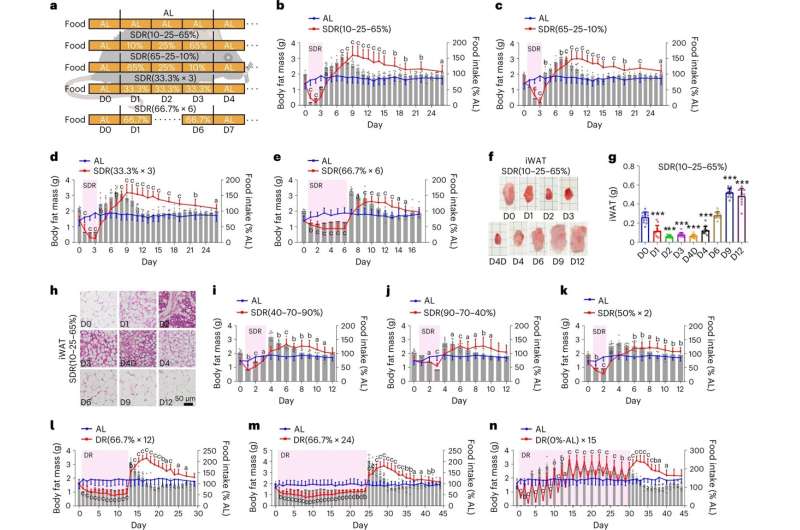Refeeding after various types of dietary restriction induces quick fat mass accumulation. a, Experimental design of SDR in mice feeding with 1-d food in 3 d or 4-d food in 6 d. AL, ad libitum; SDR(33.3% × 3), 33.3% food daily provided from day 1 to 3; SDR(66.7% × 6), 66.7% food daily provided from day 1 to 6. b–e, Refeeding after feeding with 1-d food in 3 d (b–d) or 4-d food in 6 d (e) markedly increased body fat mass, n = 9 biologically independent mice for AL, SDR(10–25–65%) and SDR(66.7% × 6), n = 7 for SDR(65–25–10%), and n = 8 for SDR(33.3% × 3). f, Representative images of isolated iWAT from the SDR(10–25–65%) group. The size for each square is 0.5 cm × 0.5 cm. D4D, day 4 at dark phase. g, The weight of iWAT in f (n = 12 biologically independent mice per group). h, Representative images of H&E-stained sections of iWAT in f. Scale bar, 50 μm. i–k, Refeeding after feeding with 2-d food in 3 d (i,j) or 1-d food in 2 d (k) significantly increased body fat mass; n = 8 biologically independent mice for AL, n = 9 for other groups. l,m, Refeeding after feeding with 66.7% food daily for 12 d (l) or 24 d (m) markedly increased body fat mass (n = 9 biologically independent mice per group). n, Refeeding after alternate-day fasting for 15 cycles markedly increased body fat mass (n = 9 biologically independent mice per group). The data shown in b–e, i–k or l–n were performed simultaneously with a single control experiment. Data are presented as mean ± s.d. Statistical significance was determined by two-tailed Student’s t-test. a, P < 0.05; b, P < 0.01; c, ***P < 0.001; versus AL or D0 group. Exact P values can be found in Source Data Fig. 1. Credit: Nature Metabolism (2022). DOI: 10.1038/s42255-022-00687-6
A study published in Nature Metabolism and led by Prof. Zhai Qiwei from the Shanghai Institute of Nutrition and Health of the Chinese Academy of Sciences has revealed that an increase of Lactobacillus and its metabolites after dieting enhanced intestinal lipid absorption and led to quick fat accumulation and obesity in mice.
It also showed that this effect could be prevented by a high-protein diet or specific antibiotics that inhibit the growth of intestinal Lactobacillus. An article commenting on this work was published in the News and Views section of Nature Metabolism.
Dietary restriction (DR), often referred to as dieting, is widely used to reduce fat mass and lose weight by restricting food intake. However, weight regain after dieting is still a big problem.
In this study, the researchers used 10 dieting protocols to investigate the effect of post-diet "refeeding" on fat mass in mice. All the data demonstrated that refeeding after dieting leads to quick fat mass accumulation and obesity. Further analysis revealed that enhanced intestinal lipid absorption, increased lipid anabolism in white adipose tissue (WAT) and decreased total lipid oxidation are the main causes of fat mass increase after dieting.
To identify potential dietary interventions to prevent fat mass increase after dieting, the researchers fed mice either a high-protein diet, low-protein diet, or normal-protein diet supplemented with essential amino acids during the post-dieting phase.
The results showed that the high-protein diet prevented quick fat mass accumulation and obesity, and even partially maintained the fat loss induced by dieting. Pair-feeding experiments involving equal-calorie normal-protein or high-fat diets showed that diet composition was more important than caloric intake in blocking fat mass increase after dieting.
Further tests also revealed that a high-protein diet after dieting reduced the levels of bile acids in the intestine and in serum, attenuated intestinal lipid absorption, decreased lipid anabolism in WAT and increased total lipid oxidation.
The researchers then analyzed the composition of intestinal microbiota and found that refeeding with a normal-protein diet after dieting dramatically increased the abundance of Lactobacillus by about 50%, and this increase was markedly suppressed when refed with a high-protein diet.
The Lactobacillus bacteria was isolated and identified as Lam-1, which is very sensitive to penicillin. The researchers discovered that treating the mice with penicillin significantly inhibited the growth of Lam-1, attenuated intestinal lipid absorption, decreased fatty acid uptake in WAT, and reduced body fat accumulation after dieting.
Tests on germ-free (GF), gnotobiotic (GB) and specific-pathogen free (SPF) mice showed, on the other hand, that supplementation with Lam-1 or its metabolites significantly enhanced intestinal lipid absorption, increased fatty acid uptake in WAT and led to fat mass increase and obesity.
This study demonstrates that refeeding after DR contributes to the development of obesity and provides important animal models for obesity research. It also suggests that using a high-protein diet or antibiotics to target Lactobacillus and inhibit intestinal lipid absorption is likely an effective strategy for preventing obesity after dieting.
More information: Wuling Zhong et al, High-protein diet prevents fat mass increase after dieting by counteracting Lactobacillus-enhanced lipid absorption, Nature Metabolism (2022). DOI: 10.1038/s42255-022-00687-6
Amir Zarrinpar, A high-protein diet prevents weight regain, Nature Metabolism (2022). DOI: 10.1038/s42255-022-00699-2
Journal information: Nature Metabolism
Provided by Chinese Academy of Sciences
























